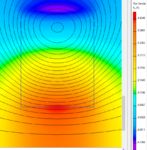Trying to give you a simple answer based on analytical arguments (formula), I realized that the expressions given above do not refer to any arbitrary point within the circle other than the center. The expression for any point however is not simple, as can be seen here: View attachment Bfield.rar, it requires calculation by numerical integration, so I insist that you consider performing experiments with the aid of simulation tools for field solving.




